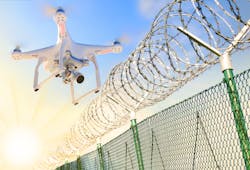This article originally appeared in the November 2020 issue of Security Business magazine. When sharing, don’t forget to mention @SecBusinessMag on Twitter and Security Business magazine on LinkedIn.
The security community had developed a love-hate relationship with drones, or unmanned aerial vehicles (UAVs) as they are more formally known. Some enterprise organizations add them as another security layer; others look to defend themselves against devices they view as a way for terrorists to deliver deadly cargo or for spies to gather corporate espionage.
Either way, security integrators are being asked to recommend, install and maintain complex systems with highly sophisticated components. It is an opportunity to get in on the ground floor of a technology that market research experts predict will grow at annual rates near 70% through 2023. Currently, there are more than 1.6 million registered drones in the United States, with about 70% owned and used by hobbyists. Commercial, law enforcement and security organizations use the rest.
For years, federal laws placed strict limitations on how most private organizations use or protect themselves from a UAV. That eased somewhat in 2017 when the Federal Aviation Administration granted some drone-use exemptions for the private sector.
Imagine a fleet of autonomous drones ready to respond to sensors detecting perimeter breaches. Within seconds, one or more UAV flies to the site, transmitting live video feeds to increase situational awareness. Enterprise organizations worldwide are successfully using this type of system today.
However, drones also have a darker side. Criminals use the devices to deliver contraband, such as weapons and mobile phones, into prison yards. And there is always fear that a terrorist group could use them to drop biological agents or explosives into a crowd of people or onto critical infrastructure. This isn’t just action movie stuff – a few years ago, a drone unloaded its payload over a sold-out San Francisco stadium crowd. Fortunately, the contents were nothing more lethal than political leaflets.
Anti-Drone Technology
Facilities housing cloud-based computer systems are vulnerable to covert cyberattacks. Targets may range from small businesses to large data centers. A small UAV landing on a roof could carry the equipment needed to break into the building’s Wi-Fi and steal intellectual property or introduce malware to disrupt operations.
A growing number of integrators now offer anti-drone systems and services. These typically expensive multi-sensor systems may include audio, visual and thermal detection, radar and other technologies capable of pinpointing the pilot’s location, determining the drone’s direction and providing data on the UAV type and its IP address.
Here’s where things can get complicated. Unlike many European countries, the U.S. has laws limiting the defensive steps many organizations could take to protect themselves. The FAA considers drones to be “aircraft,” and criminal laws against damaging or destroying a manned aircraft also apply to a 15-pound drone.
A myriad of other federal laws prohibits all but military facilities, nuclear power plants and a few other locations from taking action to shoot down a drone or jam the signal between the device and its pilot. The FAA fears attempts to attack drones could lead to accidental strikes on commercial aircraft. A wounded drone could also fall on a person causing injury. Equipment capable of jamming the signal between the UAV and the pilot might interrupt frequencies used by mobile phone networks and first responder communications. Jamming signals, permitted in many other countries, forces a drone to the ground or initiates a “return to home” flight.
There are opportunities for experienced integrators to create threat assessments and protocols to follow in case of a perceived attack, including drone drills – much like what organizations conduct to prepare for an active shooter. Well-rehearsed plans can save lives.
For example, as the site’s defensive technology detects a possible attack, gather as much information as possible – are one or multiple drones approaching? Are they flying slowly or at top speeds? A single drone flying in a nearby park isn’t likely to become a threat. Still, keep track of any UAV nearby.
Track incoming drones using high-resolution cameras with zoom lenses. Ask onsite security to get all employees and visitors indoors and away from windows and then notify local first responders and the FAA and the Department of Homeland Security – two federal agencies authorized to down drones deemed a credible threat.
Drones for Security
Increasingly, enterprise organizations see drones as a way of increasing their surveillance, patrolling and incident response efforts. Drones may augment or replace security guards. A UAV does not require health insurance, workman’s comp or 401K plans. Flying at speeds of 40 miles per hour or more, they quickly respond to calls and then hover to provide situational awareness.
However, most drones have limited flight times of 15 to 30 minutes, requiring frequent returns to base stations to recharge. Multiple drones are needed to ensure one or more is always available as needed.
There are two ways for integrators to get involved in drone security services. Integrators may create a DIY drone force by purchasing and registering a fleet of UAVs and then training and certifying pilots through an FAA-administered test. This route involves a significant outlay of time and money, and the risks associated with the technology’s complexity and the laws governing it, make it a risky investment for smaller integrators.
A better way into the business may be through out-of-the-box solutions offered by a growing number of vendors. These providers are actively seeking integrators to become partners in selling, installing and maintaining systems that include a fleet of drones, software and monitors. An operational system is up and running within hours. These solutions may be installed as stand-alone systems or integrate with a site’s existing video surveillance and access control.
Autonomous drones may patrol an area or respond to intrusion reports from sensors. Vendors program their systems to adhere to the myriad local, state and federal laws that apply to drones. Artificial intelligence enables the system’s software to become increasingly capable of identifying threats from humans and vehicles while ignoring the movements of animals and wind-blown foliage.
The quality of cameras made for drones has improved by leaps and bounds over the past decade. Though smaller in size and weight, they offer higher image quality. Drone-mounted cameras with zooms up to 30X can collect millions of pixels of high-resolution data, making them ideal for identifying people and license plates. Thermal cameras are available for nighttime use. Drone, outfitted with loudspeakers, are useful as mass communications devices.
RMR Opportunity
These new solutions are typically subscription-based which enable integrators to mark up those fees while adding their costs for monitoring and maintenance. It is possible to monitor and control multiple sites (or customers) with systems linked to a single dashboard via the cloud.
Similar systems are available for use at high-value residential properties. Autonomous drones respond to sensors, often placed in lighting, to check on possible intrusions. They reside and charge in a hub similar in size and shape to a doghouse. These systems also are subscription-based, making them another valuable addition to an integrator’s portfolio.
If choosing the subscription route, form partnerships with one or two providers at most – similar to video surveillance and access control manufacturers. To start, base your offerings on just a few products. With a sophisticated new technology, it is essential to be able to speak to customers confidently and intelligently. Purchasing and learning to fly a drone might be helpful.
The COVID-19 pandemic offers more opportunities for integrators to sell drone-related services. Factories, warehouses and other large facilities left largely unattended by stay-at-home orders require regular inspections. Drones, with their ability to ignore quarantines, are ideal for this purpose.
As with most new technologies, drones initially beg more questions than answers. Today’s high costs will drop as UAV hardware become commoditized and we discover ways drones can create income for integrators while adding convenience and security for end-users. The market is still wide open, making this a good for integrators to get in on the ground floor.
John Nemerofsky is chief operating officer of Kent, Ohio-based Sage Integration.



